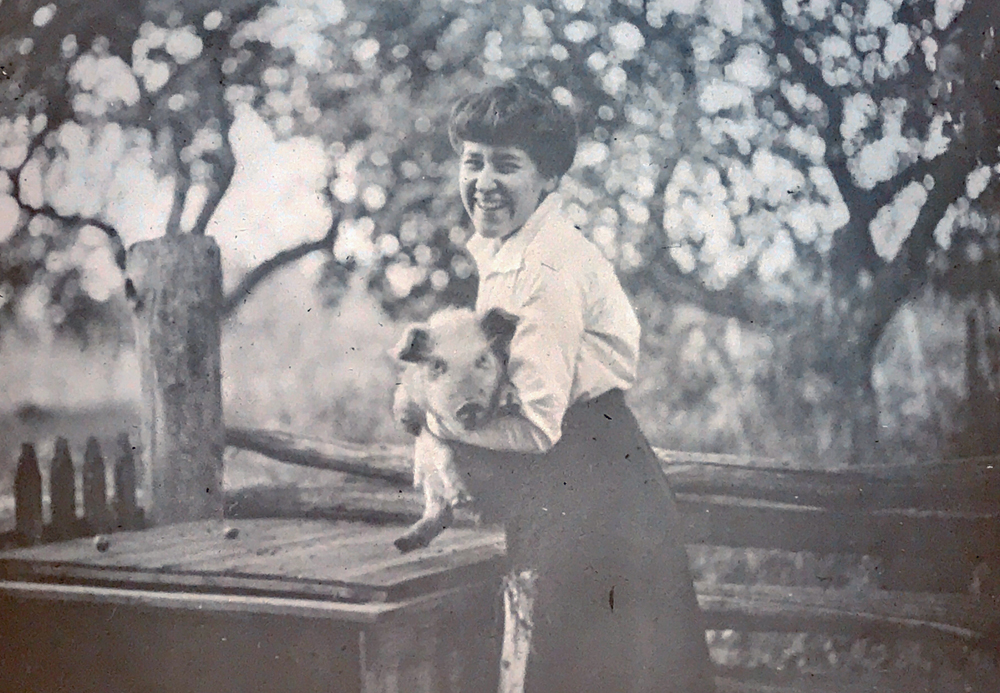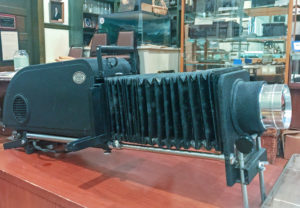True Tales from Canton’s Past: PowerPoint in 1920
By George T. ComeauThere are times when all we have are gauzy reminiscences of Canton “the way it was.” At the Historical Society we are blessed to have thousands of images of the photographic memory of Canton. Almost all of them are digitized and at some point they will become accessible on the web. With a catalogue that is so expansive, not a day goes by without some new discovery hidden in a photograph.
Just recently a neighbor brought into the society a small wooden box. Originally, the box held “cheese food,” and at some point someone cut the box in half and fashioned a lid and attached small brass sliders to make a really nice home for 26 glass plate slides. Each numbered slide had a neat, handwritten label and they didn’t quite fit into the box such that the lid wouldn’t close. The neighbor explained that his father had purchased the slides at a yard sale many years ago. The donation was logged into the system and within a few hours Jim Roache, the curator, began pawing through the images.
Glass plate slides were known as “Magic Lantern Slides,” and the technology actually predates the invention of photography. Originally, glass images would be made from drawings or paintings and then lit up by lantern or candle light and projected upon a wall. As a form of entertainment, a narrator would tell stories and music would form the soundtrack to an evening of delight and magic.
As photography flourished in the mid 19th century, the “Magic Lantern” became a way for large groups of people to see photos in a new way. A positive print would be made from a negative and then matted with a frame. Finally, a second set of glass would be sandwiched and paper tape would hold the slide together. The slides would be immune from dust and scratches and lantern slides became the rage in classrooms as well as civic gatherings. Special machines were developed and the shows would become not unlike the modern PowerPoint presentations of today.
The Canton Historical Society has hundreds of Magic Lantern slides and also owns a few projectors. Roache grabbed a screen and unpacked the Spencer Delineascope that was purchased in 1940 at a cost of $175 — the equivalent of over $3,000 today. A hefty price for a machine that would help the slides come to life. Today, you can buy antique Magic Lanterns for as little as $30 on eBay. Folks just don’t show slides anymore.
So during the last few weeks, visitors to the Historical Society were treated to slides that date to the late 1800s and bring views of the town right into the mid 1930s. That little box of slides had some powerful stories to tell. They were all numbered out of sequence, which meant they were part of a larger slide collection. And, in doing some quick research, they had been taken from a larger set that has over 170 slides. The boxes all sit neatly on a shelf inside the vault. It turns out that it was possible now to put the recently donated slides into the larger “parent” collection. A fuller understanding of the provenance of the slides came into view.
Each of the slides had a sticker on them indicating they were the property of Eliot C. French. Small typed labels had wonderful descriptions that helped caption the slides. Great captions included “favorite seat of Paul Revere — copper yard, 1908” and “Augusta Clayton and pig” followed by the 1914 “construction of cement bridge on Neponset.” All in all, we now have a nearly complete slideshow that was created by Canton native Eliot French. There is a “bomb” at Reservoir Pond, and a full series of photographs showing the construction of the phone lines throughout town in the summer of 1914. Through French’s lens we see the social life of early 20th century Canton along with a few shots of the 1920 tornado in Weymouth.
Eliot Channing French was born here in Canton in 1896, the son of Abbott French, a wealthy wool manufacturer. Education was clearly an imperative for the French family. Abbott and his brother Charles had attended prestigious Chauncy Hall, which had been founded in 1828 by Gideon Thayer on what is now the site of Macy’s in Boston’s Downtown Crossing. The school originally trained the children of wealthy Bostonians for careers in business and later prepared students to attend Harvard, MIT and other prestigious colleges. The French family did exceedingly well in Canton and beyond. Young Eliot attended Noble and Greenough School and then went on to Harvard, graduating in 1920. While in Cambridge he studied the nascent field of meteorology and became associated with Henry Comyn Clayton, the son of H.H. Clayton — one of our most famous scientists in atmospheric observations.
Upon graduation, French did a short stint as an assistant professor at Harvard. There may have been some time when French acted as an agent for H.H. Clayton and helped promote the science and scientific literature of the day. Clearly, there was an art and a science to the photographs that French took and they range from between 1908 through 1936. French was well thought of in our community and worked for New England Telephone for perhaps as many as 50 years, retiring in 1963. French was the president of Canton Co-Operative Bank and was associated with the Canton Institution for Savings. The consummate civic-minded man, French was a member of the Canton Finance Committee and very active as a Mason in the Blue Hill Lodge. Yet it was his close association as a member of the Boston Camera Club and the Canton Historical Society that yields the images we have today.
The magic in the “Magic Lantern” is the speed at which we find ourselves in another time and place. And in this box of slides our guide is Eliot French. We are walking Green Lodge Street on a July day in 1914. In another slide we are behind the switchboard of the Bay State phone company in Canton. There is the day in April 1914 that Amy Downes was caught in barbed wire and we giggle at her predicament. A beautiful portrait of French’s niece, Annie Harding, taken in 1920 with her doll is so simple and artistic. There was indeed an art to French’s photographs.
Perhaps the best shot is one that takes us to Cambridge. We are sitting in a window looking out at the Charles River from Gore Hall, room B-41. It is May 17, 1917, and the young man is perhaps lonesome and thinking of his friends back home. Through the lens of French’s camera he captures a nighttime view of the lights of the city beyond his Harvard dorm room. French has left us a gift of a time long lost, but seemingly never forgotten.
The Canton Historical Society will hold a slideshow using early 20th century technology and featuring the French Glass Slide Collection on Saturday, January 18, at 7:30 p.m. Tickets are available at CantonHistorical.org. Space is limited, so please reserve your space today.
Short URL: https://www.thecantoncitizen.com/?p=63339












